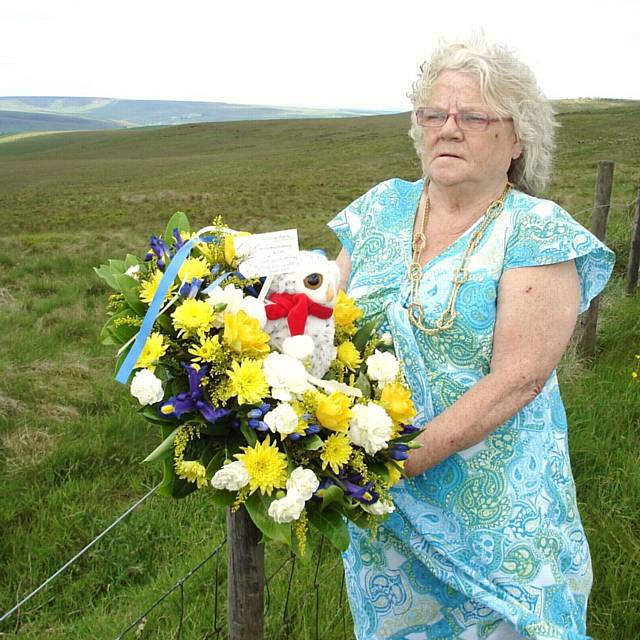50 years ago today the Moors Murders monsters got life
Reporter: KEN BENNETT
Date published: 06 May 2016
I AM focussed on the blank, unfathomable eyes of two people sitting side by side in a courtroom with blood on their hands.
Ian Brady, haughty, arched eyebrows with pouting lips, and his willing accomplice blonde-haired, Myra Hindley were on remand for killing Edward Evans at their home in Hattersley.
At that time, the chilling slaughter of the 17-year-old was the only murder recorded against them.
Yet, during their brief weekly appearances at Hyde magistrates court, they never once glanced at each other.
Instead they sat, bolt upright with unflinching stares at the thronged press benches filled with the world’s media.
Looking back, it was a frightening and surreal scenario.
Legal restrictions meant the couple’s remand appearances were dismissed in a couple of paragraphs, consigned to the bottom of a page.
But page one and centre spreads of newspapers worldwide screamed every minute detail of a relentless search on Saddleworth Moor for missing children.
Because the shocking reality was detailed police investigations into Brady and Hindley had already revealed grisly evidence of their sadistic legacy of death.
I was on Saddleworth Moor the day the first police spade dug into the cold peat. It was a cruel introduction to a relationship that was to resonate throughout my life.
Remember the times: These were the swinging 60s filled with The Beatles, button-down shirts and mini skirts. People didn’t kill children and bury them in these shockingly beautiful locations.
But they had and did.
It was hard to accept the shocking reality that we were all on a tragic journey that would eventually lead to the discovery of the bodies of Pauline Reade, John Kilbride and Lesley Ann Downey buried in shallow graves.
And as Brady and Hindley continued their courtroom silence the magnitude of their terrible crimes began to unfold.
However for me, the overriding reality was first brought home after John Kilbride had gone missing from Ashton.
Vanished
It was here in 1964 I was to renew a long standing friendship with new CID chief, Joe Mounsey who I first met as a detective sergeant some years earlier when I was a junior reporter.
John Kilbride had vanished a year earlier after last being seen on the town’s market ...
But Big Joe, a miner’s son, was determined to crack the case and the little boy became known as “Mounsey’s lad” to his colleagues.
Every week, he would visit the Kilbride family and, over a cup of tea in his office after one meeting, I asked him to share his thoughts.
His response still sends a chill down my spine. He stared balefully over the rim of his cup and said: “He’s dead and he’s been bloody murdered.”
It was a prophecy that was to come true when John’s body was discovered by the tenacious detective as part of the ongoing moors investigation in 1965. And ironically, it was Joe’s widow Margaret, herself a former police woman, who was a key source for the acclaimed ITV 1 drama “See No Evil: The Moors Murders” shown in 2007.
Played on screen by actor George Costigan, the late detective was at the heart of the police work which uncovered Brady and Hindley’s killing spree.
Later described as one of Britain’s most renowned and innovative senior police officers, Mounsey shook up sections of the police who had all but given up the search.
At the time the film’s writer Neil McKay, said: “The attention paid to the children who went missing was much less than would be the case today.
“The mid-sixties was a more innocent world, in which front doors remained unlocked and parents did not feel the need to watch over their children as they played out in the streets.
“Without Mounsey, it is unlikely any of the children would ever have been found, or Brady would have been convicted of their murders – or indeed that Hindley would ever have gone to jail at all.”
Joe Mounsey died in 1997 at the age of 73. He was awarded the Queen’s Police Medal for his work at the head of Lancashire CID and became assistant chief constable in 1976. He retired in 1988, when he was awarded the OBE.
The father-of-three’s two sons also went on to become policemen.
Most Viewed News Stories
- 1Two Oldham students study at both Oxford AND Cambridge
- 2No trams to run between Oldham and Rochdale on Sunday
- 3New football pitch and cricket nets to be built inside glass makers factory
- 4Head confident that Saddleworth School is still 'heading in the right direction' despite 'Requires...
- 5HSBC bank branch in Oldham temporarily closes for a month





